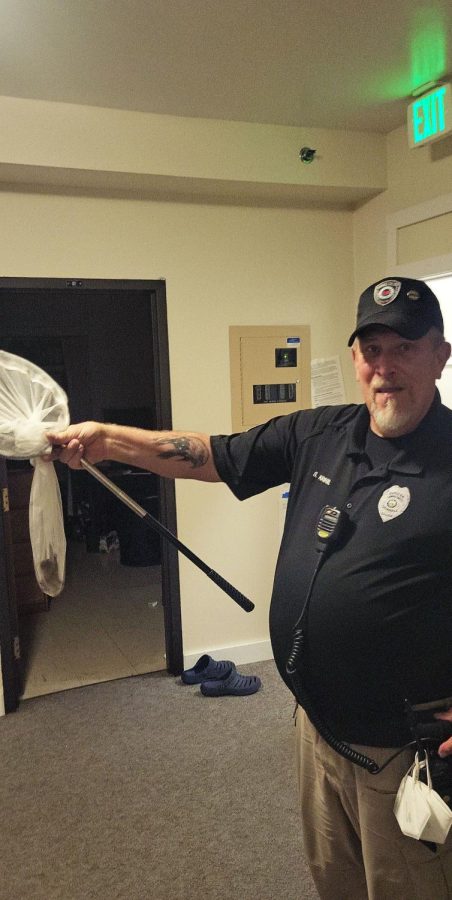Increased bat encounters welcome students back to campus
Contributed by Shayna Josephson
Campus Safety Officer Steve Kriegel holds a net with the bat he captured at Game House.
September 12, 2022
In August 2022, Campus Safety received 51 wildlife-related complaints on the Grinnell College campus, according to Director of Campus Safety James Shropshire. These cases have led to at least one student requiring a rabies immunization.
According to Dennis Perkins, Assistant Dean of Residence Life (Reslife) and Student Conduct, most interior bat sightings have been reported in the South Campus residence halls of Haines, Read, James, Cleveland and Main as well as in two project houses: Global House and Game House. Apart from Smith Hall, which is in North Campus, these residences all lie on the 1200 block of East Street.
Besides being sources of surprise and distress for unsuspecting residents, the animals can transmit rabies.
According to the Iowa Department of Public Health (IDPH), three circumstances constitute rabies exposure: bites, exposure of an open wound or mucous membrane to bat saliva or neural tissue and inability to confirm a lack of exposure, such as in cases where the exposed person was asleep or unconscious. In the third case, unless the bat is captured and tests negative for rabies, IDPH recommends hospital treatment for rabies, a series of eight injections over four appointments.
The Grinnell Regional Medical Center could not be reached to disclose the number of individuals reporting for rabies exposure treatment in Grinnell.
Daniel Stewart `26 is completing the post-exposure immunization series at the Grinnell Regional Medical Center, after encountering a bat in James Hall at the end of August. He and his roommate awoke to a bat flying around the room, which falls under the IDPH criteria for potential rabies exposure.
Stewart described his residence hall as being trapped in a “crazy cycle of people sleeping while bats enter the room,” even when fire doors and other possible entrances were shut.
While there are sporadic reports of bats in residence halls each year, this year’s season stands out in the number of reports and exposures, said Perkins. The College had previously handled incidents on a case-by-case basis, with Campus Safety responding to live incidents and Facilities Management (FM) patching potential entry points as they were identified. However, due to this year’s increased number of reported incidents, as well as general concentration of these incidents in South Campus, the departments of FM, Reslife and Campus Safety are collaborating to address the issue.
Students living in campus residences where multiple bats have been reported expressed frustration with elements of the College’s response thus far.
Shayna Josephson `23 cited frustration with communication and delayed responses from College offices following at least three bat sightings in Game House between mid-June and late-August.
In June, she found a bat in the kitchen and called Campus Safety, who arrived and removed it with a net.
In early Aug. Josephson heard a series of strange noises emanating from the bathroom and found another bat in the bowl of the toilet. She again called Campus Safety for assistance with removing the bat and asked an officer to assist her in inspecting the house to ensure that there were no more bats or open entry points. While they did not find any more bats in the main section of the house, they were not able to get into the attic because Campus Safety did not have the key.
Following the second bat incident, Josephson examined the house and submitted to Reslife a list of eight locations in the house that had holes or raised ceiling tiles that could potentially allow bats into the house. FM caulked the holes, but Josephson said that the chain of command for who was responding to her reports was “vague,” and it was at times unclear who she should be in touch with to resolve the issue.
As the semester began, another Game House resident encountered a bat in the kitchen, which flew upstairs before being removed by Campus Safety.
Perkins said that the College’s response to bat incidents has continued to evolve as more information becomes available. A “step by step protocol” for responding to bat reports is now in the works. Campus Safety is also now sharing bat reporting incidents directly with Reslife once they are resolved.
A bat expert visited campus in the last week of Aug. and is preparing a report for FM that will include information on bat behavior and key steps for excluding bats from residential buildings.
“Based on the expert’s advice, we are assessing structures to ensure that we have identified and are able to take steps to keep bats from coming inside,” wrote Amy Van Manen, the Office Manager for FM, in an email to the S&B.
According to Perkins’ Aug. 29 email to the student body, students who encounter a bat in their residence should report the incident to Campus Safety by calling 641-269-4600. If a student has potentially been exposed to rabies, they should call SHAW at 641-269-3230 to learn about next steps. Students found to be at risk will be referred to the Grinnell Regional Medical Center for evaluation and treatment.
Editor’s note: Daniel Stewart is a staff writer for the S&B. Stewart was not involved in the writing or editing of this article.

















































